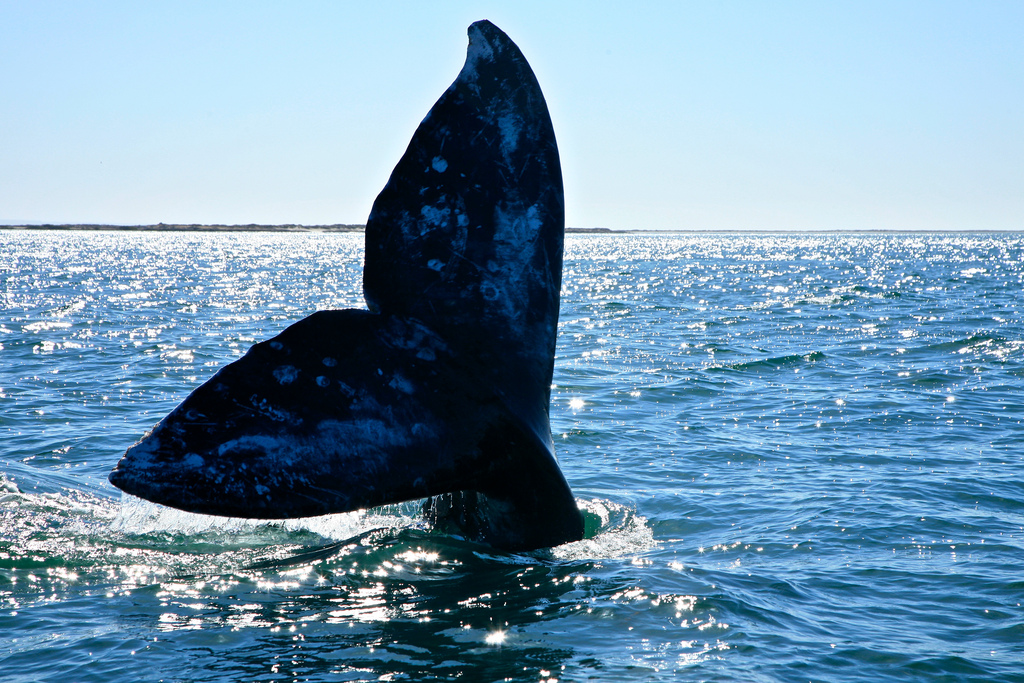
GRAY WHALE SKIN
Skin parasites (including barnacles and whale lice) attach themselves to the head area, back, and blowhole area also. Orcas hunt gray whales off the Pacific Northwest coast near Oregon, USA. Killer whales (orcas), the large sharks, and humans are the gray whales' only natural predators. The spout of the gray whale is a noisy stream that rises 10-13 feet (3-4 m) above the water. Between deep dives they take deep breaths for about 3-5 minutes. At rest, gray whales spout (breathe) 2-3 times per minute. Gray whales breathe air at the surface of the water through 2 blowholes located near the top of the head. Spyhopping is another gray whale activity in which the whale pokes its head up to 10 feet (3 m) out of the water, turning around slowly, to take a look around.

This may help clean off some of the encrustations of parasites (barnacles and whale lice) or in communicating with other gray whales. They also breach, jumping partially out of the water and falling back at an angle, splashing and making a loud noise. They can swim in even relatively shallow water without running aground. Gray whales can dive for up to 30 minutes and go 500 feet (155 m) deep. Large groups (up to hundreds of whales) form in feeding waters, but these are loose, temporary associations. Gray whales congregated in small pods of about 3 whales, but the pod may have as many as 16 members. The huge, narrow, pink tongue of the gray whale is used to dislodge the food from the baleen, and weighs about 1-1.5 tons (0.9-1.36 tonnes). The baleen bristles are thicker than those of the other baleen whales and are gray with yellowish bristles. The largest plates are about 15 inches long and 10 inches wide. The baleen plates in the gray whale's jaws have about 160 pairs of short, smooth baleen plates. They live off their thick layer of blubber (fat). During migration and while in the warm breeding waters (about 3-5 months), gray whales eat very little. The tongue loosens the amphipods (and other tiny food) from the baleen plates and the whale swallows the food. Their baleen filters out the nourishing organic material (mostly amphipods), and the whale spits out the mud. They usually feed on their right side, sucking up mouthfuls of mud filled with organic matter. They filters out small crustaceans (1/2 inch (1.2 cm) long shrimp-like crustaceans called amphipods, krill, copepods, etc.), plankton, and mollusks (including squid and fish) from the ocean sediment. They sieve through the mud on the bottom of the ocean floor of the Arctic with their baleen. They are bottom feeders (benthic feeders). Gray whales (like all baleen whales) are seasonal feeders and carnivores.
GRAY WHALE SERIES
The gray whale has two broad flippers, no dorsal fin, and a series of small ridges along the its back near the flukes (tail). These grooves allow their throat to expand during the huge intake of water during filter feeding. Gray whales have 2-4 throat grooves, about 5 feet (1.4 m) long each. There are little or no parasites on its right side because of the way it scrapes along the ocean bottom to feed. The gray whale's skin is usually gray with some blotchy white spots and has many parasites, including hundreds of pounds of barnacles and whale lice. Females are larger than males, as with all baleen whales. Gray whales grow to be at most 45-50 feet (13.8-15 m) long, weighing about 36 tons (33 tonnes).

These are used as tactile sensors, like cat's whiskers. There are hairy bristles (vibrassae) on the gray whale's snout and the front of the head. They have a layer of blubber up to 10 inches (25 cm) thick. Whalers used to call them "devilfish" because of their fierce defense they put up when hunted. The gray whale is a baleen whale (it is a filter feeder). Today's featured page: Sun, Earth, and Moon Model is a user-supported site.Īs a bonus, site members have access to a banner-ad-free version of the site, with print-friendly pages.


 0 kommentar(er)
0 kommentar(er)
